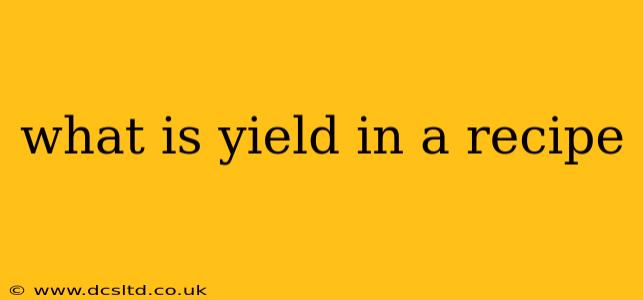Yield, in the context of a recipe, refers to the amount or quantity of the finished dish the recipe produces. It's a crucial piece of information that helps you plan your cooking and ensures you have enough ingredients or adjust the recipe to suit your needs. Think of it as the final output of your culinary efforts.
Instead of simply saying "makes a cake," a well-written recipe will specify the yield, for example: "Yields 12 cupcakes," "Yields one 9-inch pie," or "Yields 4 servings." This precise measurement allows for accurate scaling and portioning.
Why is Knowing the Yield Important?
Understanding the yield is vital for several reasons:
-
Ingredient Planning: Knowing the yield helps you determine if you have enough ingredients on hand. If a recipe yields 8 servings and you only need 4, you can easily halve the ingredient quantities. Conversely, if you need to feed a larger group, you can multiply the recipe accordingly.
-
Portion Control: Yield helps manage portions, especially when catering or cooking for a crowd. If the yield is stated as "6 servings," you know that each serving should be roughly one-sixth of the total dish.
-
Recipe Scaling: Many recipes can be successfully scaled up or down, as long as you adjust the ingredient quantities proportionally. Knowing the yield is the starting point for this crucial adjustment.
-
Time Management: Recipes with larger yields often take longer to prepare and cook. This knowledge assists in better time management in the kitchen.
-
Storage Planning: The yield helps you decide how much of the dish you'll need to store and in what type of containers.
Frequently Asked Questions (FAQs)
Here are some common questions about yield in recipes, answered to enhance your understanding:
What if a recipe doesn't state the yield?
If a recipe omits the yield, it's often because it's a very simple recipe, or the amount is somewhat flexible. In such cases, use your best judgment based on the ingredient quantities and the type of dish. A recipe for a single serving of oatmeal, for instance, doesn't necessitate a yield statement.
How do I adjust a recipe's yield?
Adjusting a recipe’s yield is straightforward. First, determine the desired yield (e.g., you want to double a recipe that yields 4 servings). Then, multiply all the ingredient amounts by the scaling factor (2 in this case). However, some baking recipes may not scale perfectly due to the complexities of chemical reactions.
What's the difference between yield and serving size?
While closely related, yield and serving size aren't interchangeable. Yield refers to the total amount of the finished dish, while serving size indicates the recommended portion for a single person. A recipe might yield 12 cookies, but the serving size could be 2-3 cookies per person.
Can I ignore the yield in a recipe?
While not strictly necessary for every recipe, paying attention to the yield is strongly recommended, particularly for more complex dishes and when cooking for others. Ignoring it can lead to insufficient food, wasted ingredients, or improperly portioned servings.
By understanding and utilizing the information provided by the yield statement, you can become a more efficient and confident cook, ensuring you always have enough food, without excess waste. Mastering this seemingly small detail can significantly improve your overall culinary experience.
